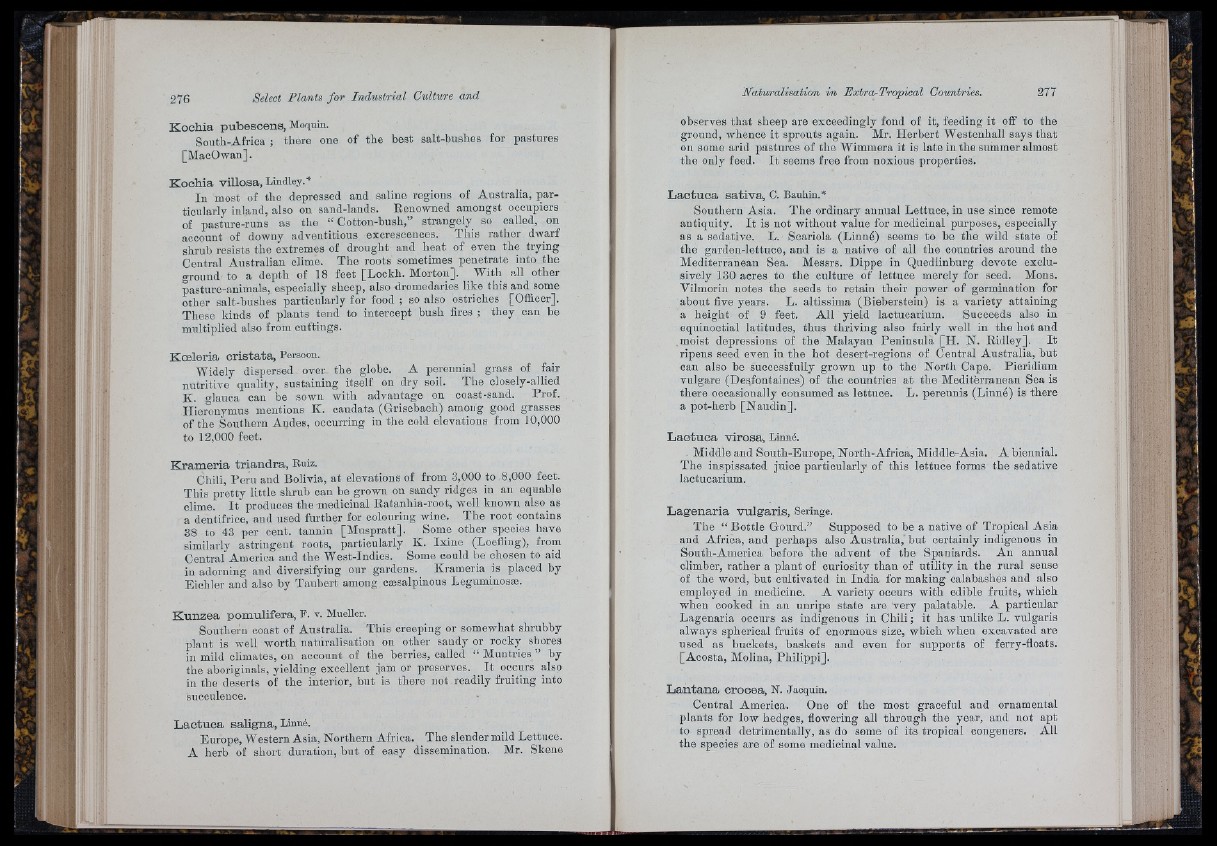
K o c h ia p u b e s c e n s , Moquin.
South-Africa ; there one of the best salt-bushes for pastures
[MacOwan].
K o c h ia v illo s a , Lindley.*
In most of the depressed and saline regions of Australia, particularly
inland, also on sand-lands. Renowned amongst occupiers
of pasture-runs as the “ Cotton-hush,” strang-ely so called, on
account of downy adventitious excrescences. This rather dwarf
shrub resists the extremes of drought and heat of even the trying
Central Australian clime. The roots sometimes penetrate into the
ground to a depth of 18 feet [Lockh. Morton]. With all other
pasture-animals, especially sheep, also dromedaries like this and some
other salt-bushes particularly for food ; so also ostriches [Cfficer].
These kinds of plants tend to intercept bush fires ; they can he
multiplied also from cuttings.
K c e le ria c r is ta ta , Persoon.
Widely dispersed over the globe. A perennial grass of fair
nutritive quality, sustaining itself on dry soil. The closely-allied
K. glauca can be sown with advantage on coast-sand. Prof.
Hieronymus mentions K. caudata (Grisebach) among good grasses
o fth e Southern Andes, occurring in the cold elevations from 10,000
to 12,000 feet.
K r am e r ia tr ia n d r a , Ruiz.
Chili, Pern and Bolivia, a t elevations of from 3,000 to 8,000 feet.
This pretty little shrub can be grown on sandy ridges in an equable
clime. I t produces the medicinal Ratanhia-root, well known also as
a dentifrice, and used further for colouring wine. The root contains
38 to 43 per cent, tannin [Muspratt], Some other species have
similarly astringent roots, particularly K. Ixine (Loefling), from
Central America and the West-Indies. Some could be chosen to aid
iu adorning and diversifying our gardens. Krameria is placed by
Eichler and also by Taubert among cæsalpinous Leguminosæ.
K u n z e a p om u life ra , P. v. Mueller.
Southern coast of Australia. This creeping or somewhat shrubby
plant is well worth naturalisation on other sandy or rocky shores
in mild climates, on account of the berries, called “ Muntries ” by
the aboriginals, yielding excellent jam or preserves. I t occurs also
in the deserts of the interior, but is there not readily fruiting into
succulence.
L a o tu o a s a lig n a , Linné.
Europe, Western Asia, Northern Africa. The slendermild Lettuce.
A herb of short duration, but of easy dissemination. Mr. Skene
observes th a t sheep are exceedingly fond of it, feeding it off to the
ground, whence it sprouts again. Mr. Herbert Westenhall says that
on some arid pastures of the Wimmera it is late in the summer almost
the only feed. I t seems free from noxious properties.
L a c tu c a s a tiv a , C. Bauhin.*
Southern Asia. The ordinary annual Lettuce, in use since remote
antiquity. I t is not without value for medicinal purposes, especially
as a sedative. L. Scariola (Linné) seems to be the wild state of
the garden-lettuce, and is a native of all the countries around the
Mediterranean Sea. Messrs. Dippe in Quedlinburg devote exclusively
130 acres to the culture of lettuce merely for seed. Mons.
Vilmorin notes the seeds to retain their power of germination for
about five years. L. altissima (Bieberstein) is a variety attaining
a height of 9 feet. All yield lactucarium. Succeeds also in
equinoctial latitudes, thus thriving also fairly well iu the hot and
moist depressions of the Malayan Peninsula [H. N. Ridley]. I t
ripens seed even in the hot desert-regions of Central Australia, but
can also be successfully grown up to the North Cape. Picridium
vulgare (Desfontaines) of the countries a t the Mediterranean Sea is
there occasionally consumed as lettuce. L. perennis (Linné) is there
a pot-herb [Naudin].
L a o tu c a v iro s a , Linné.
Middle and South-Europe, North-Africa, Middle-Asia. A biennial.
The inspissated juice partioularly of this lettuce forms the sedative
lactucarium.
L a g e n a r ia v u lg a r is , Seringe.
The “ Bottle Gourd.” Supposed to be a native of Tropical Asia
and Africa, and perhaps also Australia,' but certainly indigenous in
South-America before the advent of the Spaniards. An annual
climber, rather a plant of curiosity than of utility in the rural sense
of the word, but cultivated in India for making calabashes and also
employed iu medicine. A variety occurs with edible frnits, which
when cooked in an unripe state are very palatable. A particular
Lagenaria occurs as indigenous in Chili ; it has unlike L. vulgaris
always spherical fruits of enormous size, which when excavated are
used as buckets, baskets and even for supports of ferry-floats.
[Acosta, Molina, Philippi].
L a n ta n a oroc e a , N. Jacquin.
Central America. One of the most graceful and ornamental
plants for low hedges, flowering all through the year, and not apt
to spread detrimentally, as do some of its tropical congeners. All
the species are of some medicinal value.